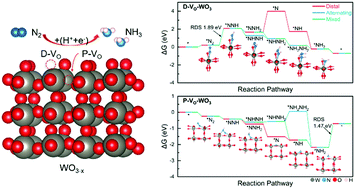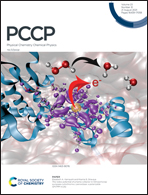Vacancy engineering of WO3−x nanosheets for electrocatalytic NRR process – a first-principles study†
Abstract
It has been proved experimentally that tungsten oxide (WO3) in a defective state has a positive effect on nitrogen reduction reactions (NRRs) owing to the surface modification by adding oxygen vacancies and doping. However, the role of different oxygen vacancies in the electrocatalytic NRR is still behind the scenes. In this study, we have carried out first-principles calculations to grapple with its causes and consequences, focusing on the two-dimensional WO3−x surface on an atomic scale. Our study shows that WO3 does not promote nitrogen reduction simply by a dimension reduction without oxygen vacancy. Two NRR processes, which are found to follow the associative mechanism in various pathways, are initiated at relatively lower potentials at two possible vacancies. It is the polarized electrons after being adsorbed over the dangling oxygen vacancy, which weaken the N![[triple bond, length as m-dash]](https://www.rsc.org/images/entities/char_e002.gif) N bond and enables N2 reduction with a rate-limiting potential as large as −1.89 V. In contrast, the desorption of NH3 from the planar vacancy is kinetically challenging at a cost of 1.47 eV, in which case the d orbitals of under-coordinated W match the p orbitals of N and form both bonding state and anti-bonding state. It demonstrates that P–VO–WO3 and N2 can bond firmly but NH3 desorption ought to pay a price. Two alternative schemes are accordingly proposed to balance good nitrogen adsorption and desorption. This noble metal-free system, by regulating vacancy sites, demonstrates its potential as an eco-friendly and fine-grained artificial material for electrochemical nitrogen reduction.
N bond and enables N2 reduction with a rate-limiting potential as large as −1.89 V. In contrast, the desorption of NH3 from the planar vacancy is kinetically challenging at a cost of 1.47 eV, in which case the d orbitals of under-coordinated W match the p orbitals of N and form both bonding state and anti-bonding state. It demonstrates that P–VO–WO3 and N2 can bond firmly but NH3 desorption ought to pay a price. Two alternative schemes are accordingly proposed to balance good nitrogen adsorption and desorption. This noble metal-free system, by regulating vacancy sites, demonstrates its potential as an eco-friendly and fine-grained artificial material for electrochemical nitrogen reduction.



 Please wait while we load your content...
Please wait while we load your content...